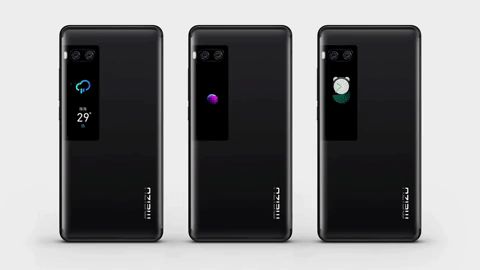Humans like instant gratification. That was true long before smartphones existed, but pocket computers have only intensified the problem. People have tried to escape the constant ping of information by developing new behaviors: They stack their phones on top of each other at restaurants and bars to see who will break first (someone always does). They flip their phones screen down when in the company of others, as if to say, “I swear, I’m listening this time.”
Screens seem to be the root of the problem. But the inanimate backside of the phone isn’t totally innocent either. That blank space only contributes to our notification FOMO, and the compulsive desire to know everything, all the time, right when it happens.
Meizu, the Chinese phone manufacturer, has an unorthodox solution to screen addiction: add another screen, this time to the back of the phone. Today, the company introduces the Meizu Pro 7, a sleek smartphone with a 2-inch rectangular touchscreen that cuts across the back left side of the phone. The full-color LCD screen displays things like the weather, messages, email, fitness activity, and alarms. It also serves as a handy viewfinder for snapping selfies with the outward facing camera.
As far as functionality goes, Meizu's rear screen doesn’t do anything the front screen can’t. Rather, its design follows the assumption that making information glance-able will ultimately lead to less dependence on our gadgets.
Ian Lee, creative director at design consultancy Frog who worked with Meizu to develop the Pro 7, explains that the idea for the rear screen came from observing how people in China, ages 25 to 30, used their phones. Lee says that people would routinely flip their gadgets face down in social situations, but they still felt anxious to check if they had any new notifications. “They want to feel connected to the digital world, but don't necessarily want to be immersed in it all the time,” he says.
A rear screen, he figured, could appease people’s notification anxiety without trapping them in deeper distraction. Currently, you can’t read messages or emails on the small display, though Lee says that eventually you’ll be able to send stock responses. “People can choose between a glance-able experience or an immersive one,” he says. “Right now, you don’t have that choice.”
Other phone makers have attempted to crack the dual screen design, but Meizu's approach is notable for its restraint. Look at a company like YotaPhone, which showed off a phone model in 2014 featuring an LCD screen on the front and full e-ink screen on the back. People were simultaneously overwhelmed and underwhelmed by the jam-packed gadget. “They made the mistake of making it two products in one,” says Lee. “We felt like that wasn’t the right way to go.” Meanwhile, Samsung has teased its vision of a futuristic dual-screen phone for years. It’s even gone as far as to integrate an LCD screen into the bezel of its Edge phone, so users can glance at notifications without turning on the full display.
Meizu designed the rectangular second screen to tuck into the upper left corner of the phone, so it feels like extension of the main display. It would’ve been easier to buy an off-the-shelf smartwatch screen or slap a larger display onto the back, but Lee says that would’ve felt disruptive to users. “The way good technology makes its way into people’s lives is not to force it,” he says. “It has to feel integrated.”
Regardless of how integrated a second screen feels, it’s still too early to say exactly how people will use it. Meizu might tout the rear screen as a distraction killer, but it’s safe to assume that plenty of people will use it to less productive means. What's certain, though, is that Meizu won’t be the last company to experiment with extending the screen beyond the single-sided rectangle. That makes the Pro 7's dual display a perfect testing ground to see how—or if—second screens make sense at all.







